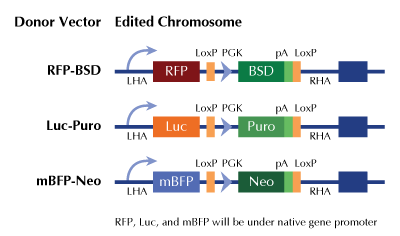Galectin 3 (LGALS3) Human Gene Knockout Kit (CRISPR)
CAT#: KN208785LP
LGALS3 - human gene knockout kit via CRISPR, HDR mediated
HDR-mediated knockout kit validation
CNY 12,260.00
CNY 3,710.00
CNY 3,990.00
CNY 2,400.00
CNY 3,705.00
Specifications
| Product Data | |
| Format | 2 gRNA vectors, 1 Luciferase-Puro donor, 1 scramble control |
| Donor DNA | Luciferase-Puro |
| Symbol | Galectin 3 |
| Locus ID | 3958 |
| Kit Components |
KN208785G1, Galectin 3 gRNA vector 1 in pCas-Guide CRISPR vector KN208785G2, Galectin 3 gRNA vector 2 in pCas-Guide CRISPR vector KN208785LP-D, donor DNA containing left and right homologous arms and Luciferase-Puro functional cassette. GE100003, scramble sequence in pCas-Guide vector |
| Disclaimer | These products are manufactured and supplied by OriGene under license from ERS. The kit is designed based on the best knowledge of CRISPR technology. The system has been functionally validated for knocking-in the cassette downstream the native promoter. The efficiency of the knock-out varies due to the nature of the biology and the complexity of the experimental process. |
| Reference Data | |
| RefSeq | NM_001177388, NM_002306, NR_003225, NM_001357678 |
| Synonyms | CBP35; GAL3; GALBP; GALIG; L31; LGALS2; MAC2 |
| Summary | This gene encodes a member of the galectin family of carbohydrate binding proteins. Members of this protein family have an affinity for beta-galactosides. The encoded protein is characterized by an N-terminal proline-rich tandem repeat domain and a single C-terminal carbohydrate recognition domain. This protein can self-associate through the N-terminal domain allowing it to bind to multivalent saccharide ligands. This protein localizes to the extracellular matrix, the cytoplasm and the nucleus. This protein plays a role in numerous cellular functions including apoptosis, innate immunity, cell adhesion and T-cell regulation. The protein exhibits antimicrobial activity against bacteria and fungi. Alternate splicing results in multiple transcript variants.[provided by RefSeq, Oct 2014] |
Documents
| Product Manuals |
| FAQs |
Resources
| 基因表达相关资源 |
Other Versions
| SKU | Description | Size | Price |
|---|---|---|---|
| KN208785 | LGALS3 - human gene knockout kit via CRISPR, HDR mediated |
CNY 12,260.00 |
|
| KN208785BN | LGALS3 - human gene knockout kit via CRISPR, HDR mediated |
CNY 12,260.00 |
|
| KN208785RB | LGALS3 - human gene knockout kit via CRISPR, HDR mediated |
CNY 12,260.00 |
|
| KN408785 | LGALS3 - KN2.0, Human gene knockout kit via CRISPR, non-homology mediated. |
CNY 8,680.00 |
|
| GA102683 | LGALS3 CRISPRa kit - CRISPR gene activation of human galectin 3 |
CNY 12,255.00 |
其它Galectin 3产品


 United States
United States
 Germany
Germany
 Japan
Japan
 United Kingdom
United Kingdom
 China
China

